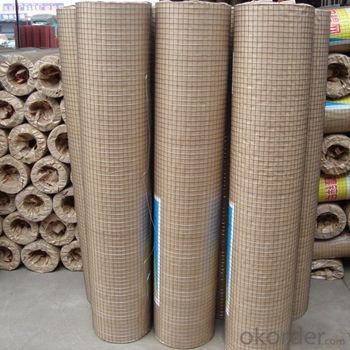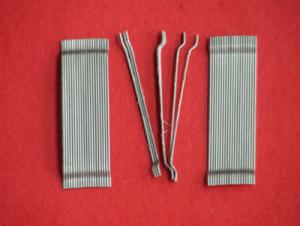high quality Stainless Steel Welded Wire Mesh
- Loading Port:
- Tianjin
- Payment Terms:
- TT OR LC
- Min Order Qty:
- 1 roll
- Supply Capability:
- 100 roll/month
OKorder Service Pledge
OKorder Financial Service
You Might Also Like
1. Welded Wire Mesh Description:
Welded wire mesh is made from stainless steel wire or galvanized wire,which shows good corrosion-resistance and oxidation-resistance,widely used for poultry houses,egg baskets,runway enclosures,draining racks,porch guards,rat-proofing, safety guards on machines, animal and plant pens and shelves, etc.
2.Main Features of the Welded Wire Mesh:
smooth mesh surface ,well-proportioned meshes ,strong welded points and bright luster .The mesh doesn’t come loose even if cut in parts or being exerted force on parts .Compared with general iron wire ,the products are better in respects of anti-corrosive and anti-rust.
3.Welded Wire Mesh Images





4.Welded Wire Mesh Specification
Specification List of Galvanized Welded Wire Mesh: | ||
Opening | Wire Diameter | |
In inch | In metric unit(mm) | |
1/4" x 1/4" | 6.4mm x 6.4mm | 22,23,24 |
3/8" x 3/8" | 10.6mm x 10.6mm | 19,20,21,22 |
1/2" x 1/2" | 12.7mm x 12.7mm | 16,17,18,19,20,21,22,23 |
5/8" x 5/8" | 16mm x 16mm | 18,19,20,21, |
3/4" x 3/4" | 19.1mm x 19.1mm | 16,17,18,19,20,21 |
1" x 1/2" | 25.4mm x 12.7mm | 16,17,18,19,20,21 |
1-1/2" x 1-1/2" | 38mm x 38mm | 14,15,16,17,18,19 |
1" x 2" | 25.4mm x 50.8mm | 14,15,16 |
2" x 2" | 50.8mm x 50.8mm | 12,13,14,15,16 |
Technical Note: 1.Standard roll length: 30m;width: 0.5m to 1.8m 2.Special sizes available at request | ||
Based on order, special sizes are also available.
5.FAQ
We have organized several common questions for our clients, may help you sincerely:
(1) How about your company?
A world class manufacturer & supplier of welded wire mesh and is one of the large-scale professional investment welded wire mesh bases in China. Annually more than 1000 containers of welded wire mesh are exported to markets in Europe, America and Australia.
(2)How to guarantee the quality of the products?
We have established the international advanced quality management system,every link from raw material to final product we have strict quality test;We resolutely put an end to unqualified products flowing into the market. At the same time, we will provide necessary follow-up service assurance.
(4) How long can we receive the product after purchase?
In the purchase of product within four working days, we will arrange the factory delivery as soon as possible. The specific time of receiving is related to the state and position of customers. Commonly 7 to 10 working days can be served.
- Q: How is steel produced?
- Steel is produced through a process called steelmaking, which typically involves the combination of iron ore, coal, and limestone in a blast furnace. The iron ore is first mined and then refined into iron through a series of heating and cooling processes. The refined iron is then combined with coal and limestone in the blast furnace, where it is heated to extreme temperatures to remove impurities and convert it into molten iron. This molten iron is then further processed to remove any remaining impurities and adjust its carbon content to create different grades of steel.
- Q: What are the different types of steel tanks and containers available?
- There are several types of steel tanks and containers available, including above-ground storage tanks, underground storage tanks, pressure vessels, intermediate bulk containers (IBCs), and shipping containers. Each type serves a specific purpose and is designed to meet different storage or transportation needs.
- Q: What are the applications of steel forgings in the aerospace industry?
- Steel forgings are widely used in the aerospace industry due to their exceptional strength, durability, and resistance to extreme conditions. They are commonly employed in critical components such as turbine disks, landing gear, wing fittings, and engine shafts. The superior mechanical properties of steel forgings ensure optimal performance, reliability, and safety in aircraft, making them vital for the aerospace sector.
- Q: Can steel be recycled?
- Yes, steel can be recycled.
- Q: What are the different types of steel chains and their uses in agricultural machinery?
- There are several types of steel chains commonly used in agricultural machinery. One type is the roller chain, which is widely used in equipment such as harvesters, balers, and combines. Roller chains are known for their strength and durability, making them ideal for heavy-duty applications. Another type is the leaf chain, which is commonly used in agricultural machinery like loaders and forklifts. Leaf chains have a high tensile strength and are designed to withstand heavy loads and shock. Additionally, agricultural machinery often utilizes pintle chains. Pintle chains are commonly used in equipment like spreaders and conveyors. They are known for their ability to handle abrasive materials and resist wear and tear. In summary, roller chains, leaf chains, and pintle chains are the main types of steel chains used in agricultural machinery. Their specific uses vary depending on the equipment and the demands of the application, but all three types offer durability and strength necessary for heavy-duty agricultural tasks.
- Q: What are the properties of tool steel for precision cutting tools?
- Tool steel for precision cutting tools typically has several important properties: 1. Hardness: Tool steels used for precision cutting tools are known for their high hardness. This allows the tools to retain their sharp cutting edges, even when subjected to high temperatures and repeated use. 2. Wear resistance: Precision cutting tools are often subjected to abrasive materials and high-speed cutting operations. Tool steels with good wear resistance properties can withstand these conditions and maintain their cutting performance over extended periods. 3. Toughness: While hardness is crucial, tool steels for precision cutting tools also need to have a certain level of toughness. This allows the tools to withstand impacts, shocks, and vibrations without chipping or breaking. 4. Heat resistance: Precision cutting tools can generate significant heat during cutting operations. Tool steels with good heat resistance properties can withstand these high temperatures without losing their hardness or temper. 5. Corrosion resistance: Precision cutting tools may be exposed to various corrosive environments, such as oils, coolants, or moisture. Tool steels with good corrosion resistance properties can prevent rusting and maintain their cutting performance. Overall, tool steels for precision cutting tools need to strike a balance between hardness, wear resistance, toughness, heat resistance, and corrosion resistance to ensure optimal cutting performance and longevity.
- Q: What is the role of steel in earthquake-resistant building design?
- The role of steel in earthquake-resistant building design is crucial as it provides strength, flexibility, and ductility to withstand and absorb the energy generated during an earthquake. Steel is used to reinforce concrete structures, such as beams, columns, and foundations, enhancing their ability to resist seismic forces. Additionally, steel frames and braces are often employed to create a more resilient and stable building system that can better withstand the lateral forces exerted by earthquakes.
- Q: How is steel used in the production of solar panels?
- Steel is used in the production of solar panels as a structural component. It is used to provide stability and support to the panels, ensuring they can withstand various weather conditions and last for a long time. Additionally, steel is also used in the mounting systems and frames of solar panels, allowing them to be securely attached to rooftops or other structures.
- Q: How is steel tubing used in the production of furniture?
- Steel tubing is commonly used in the production of furniture as it provides strength, durability, and stability. It is used to construct the frames of chairs, tables, and other furniture pieces, providing a sturdy support structure. Steel tubing can also be used to create sleek and modern designs, as it can be bent, shaped, and welded into various forms. Additionally, steel tubing is often used to create legs or bases for furniture, ensuring stability and weight-bearing capacity.
- Q: How is steel plate formed into complex shapes?
- Steel plate can be formed into complex shapes through various processes such as bending, rolling, and pressing. These techniques involve applying force and pressure to the steel plate, which allows it to be molded and shaped according to the desired design.
Send your message to us
high quality Stainless Steel Welded Wire Mesh
- Loading Port:
- Tianjin
- Payment Terms:
- TT OR LC
- Min Order Qty:
- 1 roll
- Supply Capability:
- 100 roll/month
OKorder Service Pledge
OKorder Financial Service
Similar products
Hot products
Hot Searches
Related keywords






























